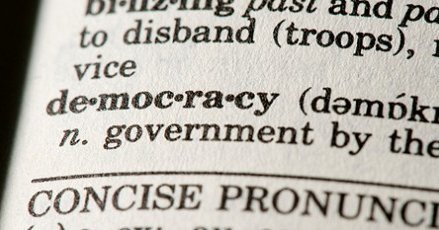The contribution of the Federalist Papers to the theory of democracy has to do with the definition of a typology of forms of democratic government and the means for compounding democratic government with liberty. As to the typology of forms of democratic government, the Federalist Papers differentiates between democracy, republic and federation.
Madison distinguishes between democracy and republic. “In a democracy, the people meet and exercise the government in person”. It is what we call assembly democracy. Instead, in a republic the people “assemble and administer [the government] by their representatives” (No.14). It is the form of government that in contemporary language is defined representative democracy. Therefore, “A democracy […] will be confined to a small spot. A republic may be extended over a large region. As the natural limit of a democracy is that distance from the central point which will just permit the most remote citizens to assemble as often as their public functions demand, […] so the natural limit of a republic is that distance from the centre which will barely allow the representatives to meet as often as may be necessary for the administration of public affairs” ( No.14).
Also the federal democracy is a form of representative democracy, but constitutes an institutional innovation, as it doubles the democratic representation and is a different form of democratic government. Hamilton places the federal principle in the evolutionary process of republican institutions: “The science of politics […] has received great improvement. […] The regular distribution of power into distinct departments; the introduction of legislative balances and checks; the institution of courts composed of judges holding their offices during good behavior; the representation of the people in the legislature by deputies of their own election: these are wholly new discoveries, or have made their principal progress towards perfection in modern times. They are means, and powerful means, by which the excellences of republican government may be retained and its imperfections lessened or avoided. To this catalogue of circumstances that tend to the amelioration of popular systems of civil government, I shall venture, however novel it may appear to some, to add one more: […] I mean the ENLARGEMENT of the ORBIT within which such systems are to revolve, either in respect to the dimensions of a single State or to the consolidation of several smaller States into one great Confederacy” ( No.9).
the federal democracy is a form of representative democracy, but constitutes an institutional innovation, as it doubles the democratic representation and is a different form of democratic government
Hamilton tries to identify which institutions made humankind progress towards good government. It is a very short list, which comprises: division of powers, bicameralism, independence of the judiciary and people’s representation in the legislative bodies. It shows that the invention of new institutions is a rare event in history. To this list he adds the federal principle.
The history of federalism begins with the Constitution of the United States. Its preamble starts with these words: “We the People of the United States […] do ordain and establish this Constitution for the United States of America”. The meaning of such words is clear. They mark the beginning of a new democratic era in the history of international organizations. A Union of States was born which had no precedent in history: its constitutional bodies have a democratic, not a diplomatic structure.
While the government bodies of the Unions of States were formed until then by the representatives of the States and their decisions were applied to States, with the American Constitution they are directly elected by the people and their decisions are directly applied to citizens. The Federation is then a State, but does not possess all the features that States were having until then: the unification of all powers in one centre. The federal institutions allow representative democracy to express itself on two (but potentially more) government levels. The federal system allows the self-government principle to be applied to a plurality of power centres, which coexist within a constitutional democratic framework that includes all of them.
This typology of forms of democratic government (assembly, representative and federal) takes into account the relation between these three institutional innovations and the enlargement of the democratic State. With assembly-democracy the democratic State could not be larger than a city, i.e. the number of people that could gather in a square. Representative democracy made it possible to extend democratic government to a national scale. Federal democracy has made it possible to form a democratic government of dimensions enclosing an entire world region, that potentially may be enlarged to the whole world (through the extension of the number of levels of democratic government).
Federal democracy has made it possible to form a democratic government of dimensions enclosing an entire world region, that potentially may be enlarged to the whole world
We can appreciate the extraordinary historical vision of the evolution of the forms of democratic government that are found in the Federalist Papers if we compare it with the point of view expressed by Robert Dahl, who is considered the most authoritative contemporary scholar of democracy. Dahl divides the history of democracy into three stages, but regarding the third stage, which he correctly defines as an attempt “to create transnational ‘democratic’ systems”, he expresses this opinion: “If the weakness of citizens in exercising final control of the agenda of collective decision-making is already a problem of the utmost seriousness in all democratic countries, then surely internationalization virtually nullifies the possibility.” (R. Dahl, Toward Democracy: A Journey. Reflections 1940-1997, 1997, I, 437).
Dahl recognizes the need to extend democracy to international level and denounces, not without reason, the limits of the results achieved thus far. But the blinders represented by the national point of view, which considers representative democracy to be the highest form of government, prevent him from appreciating the revolutionary innovations that are underway in the institutional construction of the European Union. The European Parliament is the first supranational Parliament in history and the first attempt to extend democracy to an international level in a region of the world that had experienced the tragedy of nationalism and world wars. Of course, it is an unfinished attempt, but Dahl is unable to grasp its great potential.
We can presume that anyone who had considered the functioning of the Westminster Parliament in the years immediately after the “glorious revolution” of 1688-89 would have probably expressed similar reservations (the right to vote limited to a very narrow class of citizens, excessive power of the established interests of the king and nobles, etc.). In fact, that Parliament is a pale anticipation of the House of Commons as it developed in the 19th and 20th centuries. But today we can readily say that the modern form of representative democracy has been progressively taking shape starting from that experiment, which made it possible to democratize the great territorial states governed by absolute monarchies.
Thus, today the European Union is the laboratory for a new kind of statehood inspired by a very widespread need in the world, namely that of constitutionalizing international relations. Its historical significance can be interpreted as the first stage in realizing the Kantian design of the “universal republic”. And in addition to this meaning of European unification, it is also a further step in the history of the evolution of forms of government. It is the start of the era of federalism, or rather of new forms of statehood based on solidarity among nations and international democracy.
Thus, today the European Union is the laboratory for a new kind of statehood inspired by a very widespread need in the world, namely that of constitutionalizing international relations.
India is another important laboratory for experiencing democracy within a political community with very many languages, cultures and religions, so that it can be conceived of as another model for world democracy. In fact, if Indian democracy truly is a successful test, since democracy has lasted more than 50 years in a country of more than one billion inhabitants, there is no reason to believe that similar democratic institutions are not fit for a community of six billion citizens, i.e. the world. The difference is only of quantity not quality, as Dahl believes.


Follow the comments: |
|
